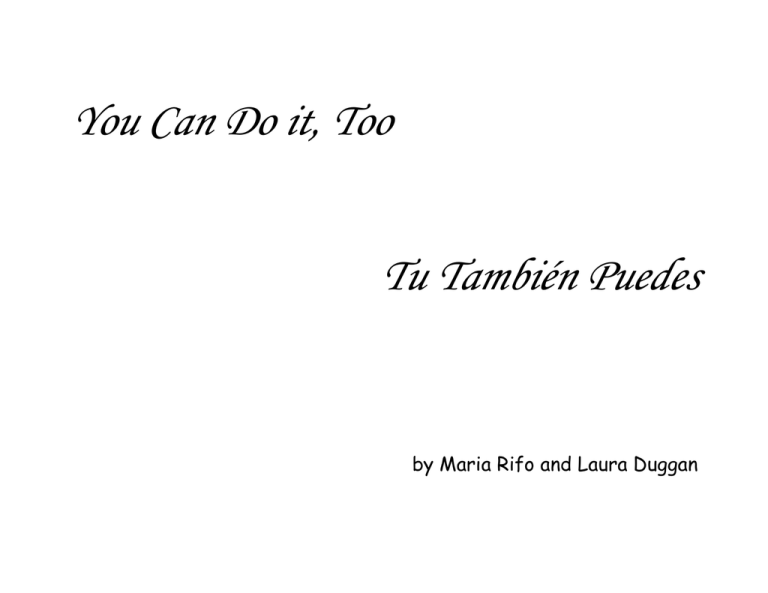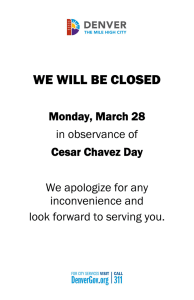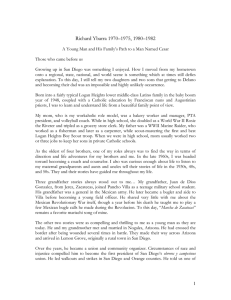You Can Do it, Too Tu También Puedes
Anuncio

You Can Do it, Too Tu También Puedes by Maria Rifo and Laura Duggan Copyright and Photo Credits ©Copyright M.Rifo/L.Duggan all rights reserved. This Book may not be resold or transferred in any way for current commercial gain. The Cesar E. Chavez Foundation is the intellectual property owner of Cesar's name, voice, image, and likeness, speeches and writings. Permission to reproduce said intellectual property for publication purposes may be obtained by contacting the Cesar E. Chavez Foundation at (213) 362-0267 or visiting their website at www.cesarechavezfoundation.org Photos: Pg 7, 9, 12, 13, 15 TM/© 2006 the Cesar E. Chavez Foundation. www.chavezfoundation.org Pg 10 Plane spraying - Cesar Chavez Foundation http://www.sfsu.edu/~cecipp/cesar_chavez/images/planeworkrs.gif Pg 14: Cesar and Medal: Cesar Chavez Foundation Poster illustration by Ignacio Gomez. Clipart images © 2003 Microsoft Corporation. All rights reserved. _________________________________________________________________________________1 Dedicated to the children who hold the future in their hands Dedicato a los niños que tiener el futuro en sus manos _________________________________________________________________________________2 Once upon a time lived a girl named Maria. She wanted to know the what and the why … the Sun… and the stars…. and the moon in the sky Una vez había una niñita muy curiosita llamada María. Quería saber el ‘cómo y porqué’ el sol salía las estrellas se recogían y la luna desaparecía _________________________________________________________________________________3 La Serena, a town that was green and quite hilly. is where she was born; in a country called Chile. Esta curiosa nena nació en un pueblito llamado La Serena… en un país lejano con cerros y llanos que Chile llamamos _________________________________________________________________________________4 Maria, the what and the why girl thought hard: What makes people happy? Why are some people sad? What makes people sick? Why are some people mad? Y María, la niña curiosa seguía pensando en muchas cosas ¿Por qué algunos son felices? ¿ Por qué otros están tristes? ¿Por qué la gente se enferma? ¿Por qué la gente se enoja? _________________________________________________________________________________5 Maria grew up and decided to travel. She had so many questions she wanted unraveled. She took planes through the skies and boats on the sea and landed at last in Washington, D.C. María creció y decidió viajar tenía tantas preguntas que aclarar. Tomar aviones y por el cielo volar y barcos navegando en medio del mar. Después de varios días aterrizar… …en un lugar de la tierra llamado Estados Unidos de Norte América. _________________________________________________________________________________6 Maria kept thinking of the what and the why: What makes people happy? What makes people sad? What makes people sick? Why are some people mad? And what can I do to make people glad? Y María sigue pensando en los “cómo” y los “por qué” ¿Por qué la gente ríe? ¿Por qué la gente llora? ¿Por qué la gente se enferma? ¿Por qué algunos se enojan? ¿Y cómo puedo yo, estas cosas mejorar? _________________________________________________________________________________7 One day when Maria went out to the west She met the first man who ended her quest. He was named Cesar Chavez. He worked in the fields. He had a big heart He knew that love heals. He knew what made people happy, He knew why some people were sad. He knew what made people sick and why people were mad. Un buen día María, se encontró con una persona que le respondió Su nombre era Cesar Chávez, el campo trabajaba tenía un gran corazón y su amor desbordaba. Sabía qué alegraba a las gentes. y porqué estaban tristes. Sabía porqué enfermaban y porqué se enojaban. _________________________________________________________________________________8 He was teaching the farm workers just what to do. Maria asked Cesar, “Can I learn from you?” Cesar said, Yes, and he gave a big smile, “Sí se puede,” he said. “You can do it, too.” He began to teach Maria all that he knew. Le enseñaba a la gente qué debían hacer María le dijo a Cesar “Yo también quiero aprender!” Y Cesar le dijo: “Sí se puede! Tu también vas a aprender!” Y le comenzó a enseñar todo lo que debía hacer. _________________________________________________________________________________9 “What makes people happy?” ”Good jobs, and fair pay and knowing your children are out of harm’s way. This makes people happy,” Cesar would say. ¿Qué hace a la gente feliz? ”Buenos trabajos y pagos justos y saber que sus hijos van a estudiar con gusto. Eso es lo que a la gente le da felicidad” respondió Cesar, sin vacilar. _________________________________________________________________________________10 “Why are some people sad?” “They work hard all day without any rest, with so little pay, No money for houses. Their kids have no schools. This makes people sad. There aren’t fair rules.” “¿Por qué algunos están tristes?” “Trabajan desde que el sol aparece hasta que el sol se acuesta Por muy poca paga y, sin ninguna siesta! Sin dinero para gastos y los niños sin zapatos. Esto deja a la gente triste -- la justicia ya no existe.” Maria still wondered, Why does this happen? and what can we do? Y María se pregunta, ¿Por qué esto pasa y qué podemos hacer? _________________________________________________________________________________11 “What makes people sick,” Maria now asked. “Planes spraying poison on crops in the field. The workers get sick,” Cesar revealed. Then eating those fruits, more people get ill. No money is left for the hospital bill. “Qué es lo que enferma a la gente?” María vuelve a preguntar. “Aviones rociando veneno en los campos de cosecha por eso enferma el obrero. Luego, al comer esas frutas mucha mas gente se enferma Sin dinero, sin remedios.” Maria still wondered, again and again Why does this happen and when will it end? The people exclaimed, “When? Yes, oh when…?” María sigue pensando, ¿Cómo terminar con ésto? Y la gente dice, !Hasta cuándo!….!Hasta cuándo!… _________________________________________________________________________________12 “What makes people mad is being mistreated and not being heard. Then people start fighting, and can’t hear a word.” Maria still wondered, “But what can we do?” “Si la gente es maltratada y no se siente escuchada, comienzan a reñir y ya no se pueden oir!” María sigue pensando, ¿Podemos hacer los cambios? _________________________________________________________________________________13 Cesar then called all the fieldworkers together. He taught them a new way to make things get better. “No need for violence. No need for fights. Learn what to say. Stand up for your rights.” Good Jobs Buenos Trabjaos Fair Pay No Poisons No Venenos Pagos Justos En la junta general Cesar consigue reunir a todos los campesinos. Conversando y de la mano todos fueron mejorando. “Sin usar la violencia. Nunca fueron a pelear. Aprendieron a pedir y sus derechos lograr.” _________________________________________________________________________________14 Working together with love and great care Cesar, Maria, and all who were there created a new way to work on the land. Their lives could improve if they worked hand in hand. They learned self-respect. They learned to be strong. They had houses, and schools where their kids could belong. Trabajando juntos con voluntad y cariño Cesar, María y los campesinos Crearon otra manera de progresar Y trabajando juntos todos pueden mejorar Aprendieron a respetarse y ser buenos vecinos Tener casa y escuelas que reciban a sus niños. _________________________________________________________________________________15 Maria now knew the what and the why. And when it came time to say her “Good Bye,” she thanked Cesar Chavez, with all of her heart, for teaching her new ways to do her small part to help people be happy, to help people find health to have patience, and goodness and great inner Wealth. Ahora María conoce los “cómo” y los “porqué” Y ya se acerca el momento de despedirse cortés, agradece a Cesar Chávez, con todo su corazón, el haber dado su vida para nuestra población Por ayudarla a ser feliz a cuidarse con amor Tener paciencia y bondad y gran riqueza interior! _________________________________________________________________________________16 What about you? What do you want to do? Sí Se Puede, You Can Do it, too… if you really want to! Y que piense usted si quiere hacer los cambios Sí Se Puede! Todos podemos hacerlo, si queremos… _________________________________________________________________________________17 About the Authors Maria Rifo was born in Chile in 1907. She lived in Chile, working as a physical education teacher and taking care of her parents until she was 55. When they passed away, she left Chile and began a new life in the USA. While working for VISTA in New Mexico in the 1960s, she heard Cesar Chavez speak and said, “I want to help him.” Ms. Rifo worked in Delano, California, serving as Cesar’s Spanish correspondence secretary and as editor and producer of the Farm Workers Union newspaper. After 12 years, empowered by her experiences with the Union, she left Delano. She dedicated the next 30 years of her life to offering her experience in support of the Latino communities. She helped create the Spanish version of Alternative to Violence Program, addressing family violence and has been honored by a variety of community groups for her selfless service. Her many awards include Sonoma County 2003 Woman of Color Humanitarian Award, the California Human Development Corp 1997 Outstanding Individual, the City of Santa Rosa 2001 Community Services Individual Award and numerous others. Maria Rifo lives in Santa Rosa, where she continues her volunteer activities. She brought a greater sense of self-esteem to disadvantaged people of every culture. She passed away at age 99 in Feb, 2006. Laura Duggan lives in Sebastopol California, where she works as a freelance editor, writer and poet. Formerly director of a non-profit Sanskrit research organization and teaching staff member for an international not-for-profit educational organization, Ms. Duggan’s main interest is in applying philosophical and spiritual wisdom to daily life. She has served as an editorial consultant for a variety of books, including books on Qi Gong, Indian Philosophy and Suze Orman’s financial books. Ms. Duggan also teaches meditation and is currently interested in creating ways for children and young people to recognize their own unique talents. Ms. Duggan is at home in a variety of cultures, having traveled, lectured and lived on all six continents. Her writing can be found at http://www.inquiringlife.com _________________________________________________________________________________18

